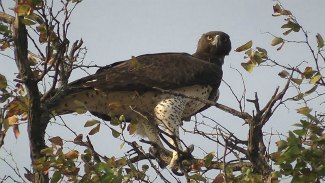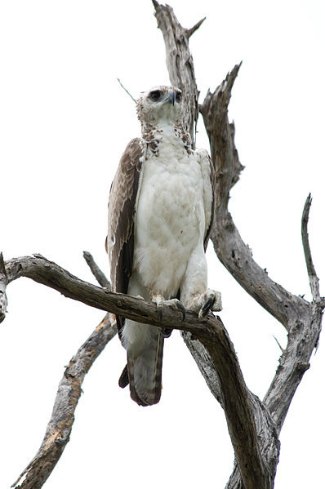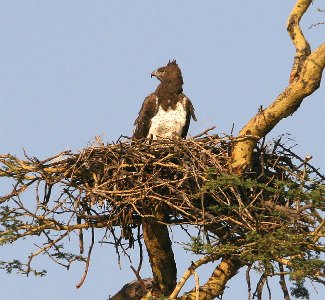Martial Eagle - Polemaetus bellicosus
By Dellex, CC0, via Wikimedia Commons
Family: Accipitridae
Genus: Polemaetus
Species: P. bellicosus
Martial Eagles live in grassland, wooded savanna, and riparian forest throughout sub-Saharan Africa. They are the largest eagles on the continent and eat a range of prey, from guineafowl to servals.
Physical Description:
Martial Eagles have a dark brown back, head, and chest. The underparts are white with black spots and the females typically have heavier markings than males. The flight feathers are streaked with black and the underwing coverts are brown. The tail is white with black streaks. The eyes are bright yellow. The beak is black and hooked, and the cere is gray. Feet are yellow. They also have a short, inconspicuous crest.
Juveniles are paler than adults with white, unmarked underparts. Eyes are brown. They reach full adult plumage after seven years.
Overall, they are relatively quiet birds. Their calls include a loud, repetitive "klee klee klee klooee kulee" and a weak "hlueee oh". Listen to a Martial Eagle.
By Chris Eason, CC-BY-2.0, via Wikimedia Commons
Size:
Length: 78-83 cm
Wingspan: 190-260 cm
Weight: 3.0-4.7 kg
Habitat and Distribution:
They occupy open grassland, wooded savanna, and riparian forests, and a void closed forest and highly arid desert. Martial Eagles are usually found from 0-1,500 meters above sea level, though they have been recorded up to 3,000 m. They spend much of their time in the air and can cover up to 100 km² in a single day.
They live in Senegal and Gambia east to Ethiopia and Somalia and south to Botswana and South Africa, over a range of 18°N to 39°S. Adults are sedentary but may travel outside of the breeding season, and juveniles disperse from their nesting grounds. There are an estimated 30,000 individuals over 29,200,000 km².
Diet and Hunting:
They eat a large range of animals. Mammalian prey includes hyraxes, hares, dik-diks, servals, and jackals, and one recorded antelope weighed close to 37 kg. Martial Eagles also take reptiles and birds such as guineafowl, bustards, and francolins. They rarely consume carrion.
They hunt by swooping to the ground at an angle and can spot prey up to 5-6 km in the air.
Reproduction:
Pairs are monogamous and form bonds that last for several breeding seasons. The breeding season itself is from February-August.
The nest is made out of sticks and built by the female in 2-3 weeks. It is placed in the fork of a tree or on a cliff or power pole 5-70 m high. Nests can be massive structures up to 1.5-2.0 m across and 2 m deep. One egg—less often two—is laid and incubated by the female for 48-53 days. Fledging takes 90-190 days and the young will remain close to the nest for 8-10 months after that, which is the reason why pairs can only breed every other year. Average productivity of Martial Eagles is 0.43 young per pair per year.
By Yoky, CC-BY-SA-3.0, via Wikimedia Commons
Conservation:
They are widespread across sub-Saharan Africa but their population has suffered from significant declines in southern and western Africa; they are believed to be extinct in regions of western Africa. Threats include habitat loss from agricultural conversion and felling of large trees, hunting, nest disturbance, poisoning, electrocution, collision with power lines, drowning in reservoirs, killing for traditional medicines, and a reduced food supply. They are currently listed as Near Threatened by BirdLife International.
Conservation measures undertaken include a system for compensating farmers for losses of their livestock caused by Martial Eagles. Conservation measures proposed include combining awareness campaigns and compensation programs and installing anti-electrocution devices on power poles.
Taxonomy:
Polemaetus bellicosus was formerly placed in genus Hieraaetus based on osteology. However, since the species is classified as a member of the genus Polemaetus by many authorities, it is categorized as such on this website.
Other Names:
Breekoparend (Afrikaans), Orel bojovný (Czech), Kampørn (Danish), Vechtarend (Dutch), Kuningkotkas (Estonian), Gasellikotka (Finnish), Aigle martial (French), Kampfadler (German), Aquila marziale (Italian), Gomabarawashi (Japanese), Ngongo gepampa (Kwangali), Kampørn (Norwegian), Wojownik zbrojny (Polish), Águila Marcial (Spanish), Tai Ngwilizi (Swahili), Stridsörn (Swedish), isiHuhwa, uKhozi (Zulu).
Video of a Martial Eagle:
References:
http://avibase.bsc-eoc.org/species.jsp?avibaseid=FDA2E4A325A048FF
http://www.biodiversityexplorer.org/birds/accipitridae/polemaetus_bellicosus.htm
http://birding.krugerpark.co.za/birding-in-kruger-raptor-eagles.html
BirdLife International (2012) Species factsheet: Polemaetus bellicosus. Downloaded from http://www.birdlife.org on
14/01/2012.
Global Raptor Information Network. 2012. Species account: Martial Eagle Polemaetus bellicosus. Downloaded from
http://www.globalraptors.org on 14 Jan. 2012
BirdLife International 2009. Polemaetus bellicosus. In: IUCN 2011. IUCN Red List of Threatened Species. Version 2011.2.
www.iucnredlist.org. Downloaded on 14 January 2012.
http://www.kenyabirds.org.uk/martials.htm
http://www.nnf.org.na/RAPTORS/raptors_pges/martialeagle.htm
http://www.planetofbirds.com/accipitriformes-accipitridae-martial-eagle-polemaetus-bellicosus
Ferguson-Lees, James, and Christie, David A. Raptors of the World. Houghton Mifflin Company, 2001.
http://www.sa-venues.com/wildlife/birds_martial_eagle.htm


